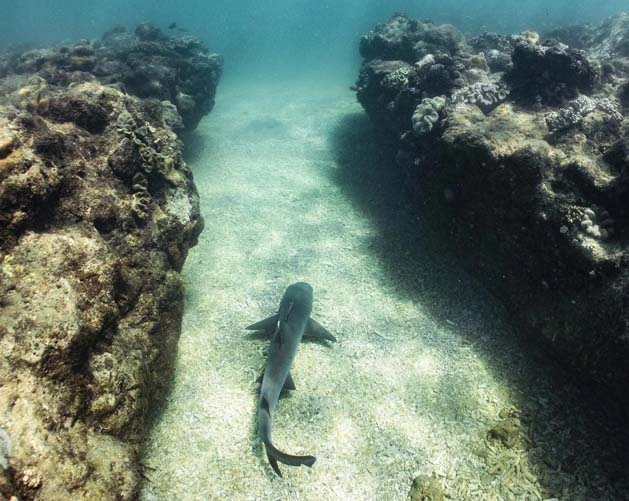These guys belong to a group of sharks we call requiem sharks which includes other species such
as the lemon shark and blue shark. Compared to their cousins, white tips are a relatively small
species reaching on average a length of 1.6m. White tips also have another difference to most of
their cousins in the requiem shark family, and that is the way they breathe. The majority of
requiem sharks are what are known as ram breathers or ventilators, this means that they must be
swimming constantly so that water moves across their gills allowing them to breath. White tips
can remain stationary on the seafloor in caves and under ledges and still breath, this is because
they use buccal pumping to breath. Buccal pumping involves water being pumped through the mouth
and then through the gills providing the shark with oxygen. The motion of this pumping gives the
appearance that the shark is huffing and puffing after a long hard swim.
This species has quite a wide distribution and can be found in waters across the whole
Indo-Pacific region. Here in Australia they can be found from the north west region of Western
Australia around the north and then south to the Southern Queensland coast. Their habitat is
coral reefs and they are most often found under ledges and in caves and crevices in the reef.
They prefer to stay as close as possible to the bottom and can be found at depths ranging from 8
meters on the shallow coastal reefs down to 40 meters on the deeper reef slopes.
They are quite easily recognised for their small size and slender body shape. Their head shape is
also quite distinct, it is short and broad not the stereotypical pointed torpedo shape and has
two tubular skin flaps at each nostril. Their mouth is turned down at the corners which gives
them a perpetual grumpy expression and is full of up to 50 teeth at a time. These teeth are
tri-cuspid which means they have 3 points, a large centre point flanked by much smaller points.
Their colouring is grey to brown with random small dark dots down their side and their dorsal and
caudal (tail) fins are tipped with white, the reason for their common name.

Like all sharks white tip reef sharks are predators, the have a nocturnal nature and are most
active at night time. During the day they are quite docile sharks and can usually be found
resting, sometimes in groups which is unusual for a shark as they are not generally social
animals. They are so calm and docile during the day that fish are not even scared of them and
will spend the day swimming around them, annoying them and even rubbing themselves up against the
sharks rough skin to scratch the parasites from their scales. However as soon as the sun goes
down this changes. The white tips wake up and turn into voracious little predators and will eat
anything that is unlucky enough to be caught out of their hiding spot, this includes fish,
crustaceans and molluscs like octopuses.
Even though they are fearsome little predators the white tip reef shark is not considered
particularly dangerous to humans and will rarely show aggression towards us. All recorded attacks
from this species were considered provoked, usually spear fisherman getting a nip while the shark
was trying to snack on their catch or people who had been attempting to hand feed them. The sad
part is that these little sharks are listed as near threatened by the IUCN. This classification
is the direct result of human interference and activity. We don’t like to eat them as they are
considered toxic due to ciguatera contamination, a result of the sharks diet, so they aren’t
considered to be overfished. However as our human industries spread over and into the world's
oceans, the coral reef habitats of these sharks are dwindling, which causes the same thing to
happen to their numbers. As they are quite slow to reproduce and have small litter sizes it is
quite difficult for this species to bounce back after a population decline.

